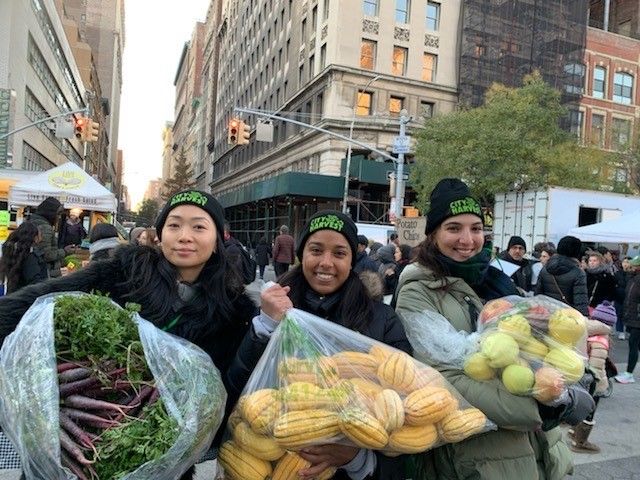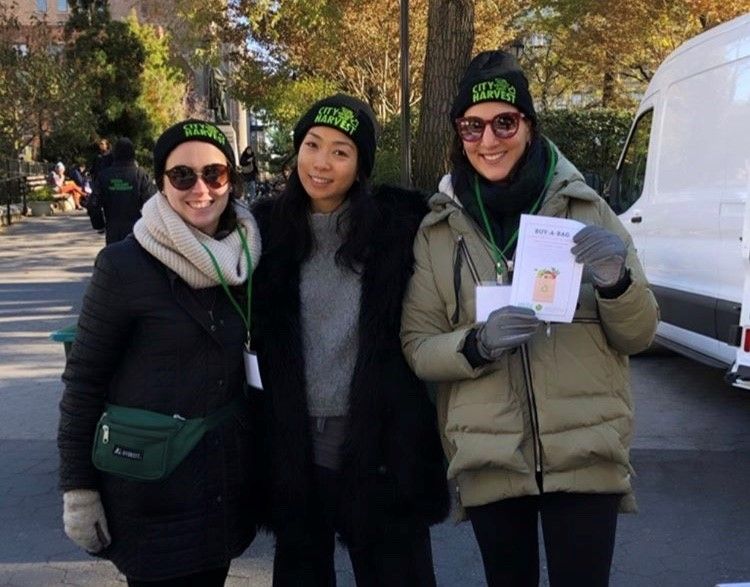It Takes A Village
AUGUST 24, 2020

Despite its size and density, when the going gets tough, New York City is really a large village whose inhabitants stand up to be counted. Gabrielle Mizrahi, from New York based food bank City Harvest, typifies that spirit and explains to Steffan Chirazi what it is to be a New Yorker on the frontline in this craziest of years.
You have to laugh. Gabrielle Mizrahi and I are chatting about her life and career when we reach the bit where she rescinded the lure of Vogue magazine for the frontline fury of working at one of the biggest food banks in Manhattan. It is not – you understand – the career choice most people would make.
“It is fair to say that before I started working at City Harvest, I really didn’t think that food insecurity was going to be an area that I was interested in working in,” she chuckles.
New York born and bred, as we chat about Gabrielle’s background, it is clear that early in life she was privy to two sides of what is a deeply multi-faceted city.
“I think in my childhood, what was really interesting was that with my mom I lived in a great neighborhood in Long Island with a great school system and no obvious signs of poverty. But at the same time my dad lived in Queens, right off of Queens Boulevard, and that was definitely a different world and a different experience, just because in New York City you are physically closer to different types of neighborhood and incomes that you don’t see as clearly in Long Island.”
Such observations earmarked Gabrielle as one of those rare, unique, and vitally important people who found a passion in working to help others rather than taking what would perhaps appear to be the more appealing career path. Not that even Vogue magazine was her first love, no, that would’ve been the field of history and a potential career as an archivist. However, Gabrielle would soon find her passions moving elsewhere.
“I was a history major at Tulane University in New Orleans, and I was 100% positive that I wanted to be in a dusty back room looking at old things,” she laughs. “I got an internship at the National World War II Museum down there, which is fantastic, and I spent my whole summer in a back room looking at old World War II pictures. It was an incredible experience, but honestly, I didn’t think I could do that for the rest of my life. Right across the street from the World War II Museum was an amazing art museum called the Ogden Museum of Southern Art, and they were looking for a development and communications intern at the time. I applied once I was done with the World War II Museum internship, and that was really where I got into the world of working in nonprofits and working in fundraising and development for nonprofits. I found that I absolutely loved it. So, when I graduated from Tulane, I got my master’s degree in London with a focus on working in nonprofit management, specifically in the arts and art museums.”

After getting her master’s degree, Gabrielle returned to New York where she found herself working for the Condé Nast publishing house and Details magazine, a spell which lasted two weeks before Details folded. No worries, there’s always a Vogue around the corner, right?
“I spent a year as an assistant there,” she laughs. “In my mind at the time, I still wanted to work in the world of arts and art museums. So my thinking was I was right out of school, I needed a job, I had this great opportunity to work at this very, very famous brand, and to me those worlds were right next to each other; art, fashion, and a high end luxury magazine, that was all like one space.”
It wasn’t long before Gabrielle was offered an opportunity at a small NYC nonprofit. It was there that she cut her teeth and got a very quick view into exactly what a nonprofit should be.
“The role was to be a development officer for an organization that helped get funding and support to arts organizations that provided opportunities for underprivileged New York City children, which to me sounded great,” Gabrielle says. “I was there for three months, I felt that they weren’t using funds in a really effective way, and as a fundraiser that was really upsetting to me because I don’t want to ask people for money if it’s not going to go and actually do good! It is really important to add that this only relates to my specific time there, as since then they have undergone a restructure.”
Gabrielle thus opened up to recruiters, and it wasn’t long before one from City Harvest got in touch. The fit was perfect, and Gabrielle was quickly engaged with the task of connecting the philanthropic side of NYC’s businesses and corporate entities with City Harvest’s needs.
“That may include volunteering and fundraising with their employees, making a grant to the organization or a direct gift to City Harvest to support our work,” she explains. “You may one day be taking to someone who usually spends their time in a boardroom and showing them one of our mobile markets, or one of our programs, educating them on the issue of hunger in New York City and showing them how they can make a difference and how they can help.”

In a city as densely populated as NYC, the issue of food insecurity reaches its long slippery tentacles into areas which can be surprising to the uninitiated.
“I think something that we say all the time at City Harvest, and something that’s really been eye-opening to me as someone who didn’t have a ton of experience in the world of food insecurity, is that we all have an image in our head of what a person who is experiencing hunger looks like, whether that’s someone who’s homeless or someone who obviously doesn’t have the money to purchase food,” says Gabrielle. “A lot of what we actually see on the ground – and what I’ve seen firsthand – are people who are wearing nurse’s uniforms going and accessing free food at a pantry, or people who work two jobs and still need to access our program. In New York City, with so many people, sometimes it’s hard to see who exactly needs help and who is not maybe obviously struggling, but still is not making ends meet.”
As if the perilous nature of an increasingly economically disparate society was not enough, COVID-19 came to not only redraw the parallelogram’s lines, but to thrust millions more into turmoil and bewilderment.
“It’s not necessarily that before it was ‘people who didn’t have jobs’ and now it’s ‘people who were laid off due to COVID,’” furthers Gabrielle, “it’s more that there are people whose salaries are being reduced because of COVID-19, there are people being furloughed because of COVID-19, there are people who were laid off for no fault of their own because of COVID-19, and who now because of this crisis, are at a level where they need to access our services as well. I think COVID-19 has exasperated a lot of what was already under the surface, which was that people were a few paychecks away from needing to access free food.”
There has been much publicity about the bizarre mountains of food which were building up due to COVID-19, food which threatened at one point to be absurdly wasted. City Harvest has been quick to identify such situations and liberate said supplies wherever possible.
“We have a food sourcing team who work both locally and nationally to help us find really healthy, good food to get out to the community in need,” enthuses Gabrielle. “I spoke to someone on our food sourcing team, and in the days after restaurants shut down, people on our food sourcing team were working 15-hour days speaking to people who had [excess] food and capturing as much of it as was possible. So we’re extremely lucky that we’ve still been able to bring in the food that we need, and not only bring in the food that we expected to bring in this year, but even more food to meet the increased need.”
I will later learn that such efforts mean that by the end of City Harvest’s fiscal year on June 30, 81 million pounds of food had been rescued and delivered. By any stretch of the imagination, that is a wholly impressive and intimidating figure.
Gabrielle is proudly enthusiastic about the levels of work and engagement which have occurred despite a global pandemic.
“On a normal basis we work with around 400 soup kitchens, food pantries, and community partners to help us get food out across all five boroughs, and quite a few of those had to close their doors in the days following the lockdown and quarantine for a number of reasons.” She furthers without pausing for breath, “It could be that they were no longer able to have reliable volunteers come in, because people weren’t leaving their homes so they didn’t have enough manpower to get the food out. It could be that the people who ran the pantry were older and they were high risk populations and they couldn’t physically be there to run the pantry anymore. There were a lot of things happening on the ground, and at the same time for us, City Harvest relies on volunteers. We have over 10,000 volunteers annually who help make our work possible. And so we also needed to figure out how do we make our work safe for volunteers, how do we make sure that people are keeping six feet apart and we’re following CDC guidelines – that we’re not putting anyone at risk. And I will say that it’s just amazing how many people really stepped up and contacted us asking how they could still help. It is really inspiring.
“We did a lot to respond to the issues which arose from pantries closing, including opening up emergency pop-up food sites and getting more food out to pantries that were open so that they could serve more people in their neighborhood. So many problems popped up, but I think it’s really admirable how the program staff at City Harvest was able to meet all those problems really quickly.”

Aside from the tangible food support, City Harvest is also heavily invested in advocacy work and the spreading of vital information for food insecure communities.
“On our website, we have a whole section for advocacy and we really push as an organization for anything that helps food insecure people,” Gabrielle affirms, “anyone can access our advocacy section and see where we stand on issues around food insecurity and actions we’ve taken in the past in support of that.”
There is no doubt, however, that the single biggest issue facing City Harvest – along with the rest of society, in fairness – is COVID-19. Trying to play the “future-trip” game is a fool’s errand under such circumstances, but City Harvest doesn’t have the luxury of sitting back and waiting for the chips to fall into place.
“We just don’t know what’s going to happen next which is what’s really difficult,” Gabrielle sighs. “Obviously for me, working so closely with our corporate partners, we see different things happening, from companies getting ready for big re-openings to those who are saying they’re going to be shuttered until next year at least, to those who are going to be continuing to work from home, to those who are really itching to get them back in the office. All of that trickles down to the economic situation; who’s going to be working, and how many people are going to be unemployed versus have jobs. It’s an unpredictable yet fast-fluid situation.”
Yet amidst the uncertainty, Gabrielle has cause for positivity as the decency and support of the New York communities has shone through these challenging times with some serious aplomb.
“Something that was initially a concern for many of us at City Harvest at the beginning [of COVID-19] was whether there was going to be this big wave of giving in the first few weeks before everyone forgot about us and forgot about food insecurity. And you know, it just hasn’t slowed down.”
Gabrielle Mizrahi smiles broadly.
“People continue to give which is amazing, and I think that people are going to still keep looking out for each other. That helps sustain me and gives me great hope.”


